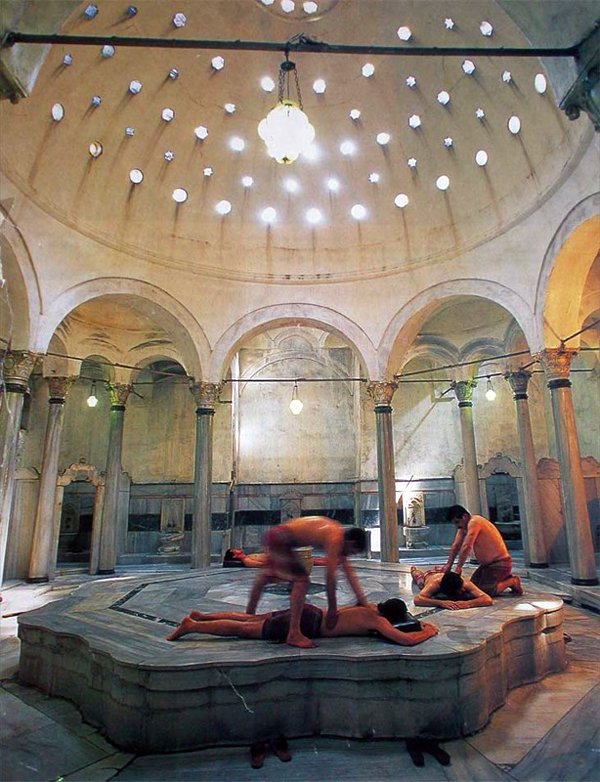Unique Experiences: Don’t leave without experiencing a Turkish Bath: Hamam

Have you tried Turkish Bath: Hamam
In a Turkish Bath, hamam there are either two separate sections for each of the sexes or different days and hours allocated to men and women.
When you enter the first section or the changing area of a hamam you begin by taking off your clothes and putting on a “peştemal”, which is a piece of striped cotton cloth. This is wrapped around the midriff and tucked into place. Some people choose to wear their bathing suits underneath or instead of the “peştemal”. A type of wooden clog, called “nalın”, is worn on the feet. They will help you not to slip on the wet marble surface.
Dressed in “peştemal” and clogs, you go to the next room where a “göbek taşı” (navel stone), a marble heated table, is situated in the middle. Marble sinks and taps all around the walls surround the room. Here, you sit next to one of these sinks and start pouring lukewarm water over yourself with a hamam tası (bowl). You keep pouring water until your skin softens, meanwhile increasing the temperature of the water as your body gets used to it.
The hamam attendant, tellak, will take you to the “göbek taşı” when your skin is ready and start rubbing your body with a special glove, kese. Tiny black pieces will get rubbed off your body that most people think is dirt. This is in fact the top layer of dead skin. At this stage a short massage is optional. Next, the tellak will give you a soapy rub down and wash you with water in decreasing temperature in order to make your pores close. He will then wrap you in towels.
Now it is time to go back to the lukewarm section to cool your body gradually while you lie down and drink tea in the traditional tiny glasses. Staying too long in the bath or moving to the hot or cold rooms without spending enough time in the lukewarm section is harmful for the body. Otherwise the whole hamam experience is something very healthy and cures lots of diseases.
About Turkish Bath: Hamam
A Turkish Hamam, known as a “hamam” in Turkish, is a traditional bathing and cleansing ritual that has been an integral part of Turkish culture for centuries. The Turkish bath combines elements of both Roman and Byzantine bathing practices and has its own unique features. Here is an overview of the Turkish bath (hamam):
- Historical Significance: Turkish Hamam have a long history that dates back to the Roman and Byzantine periods. However, they became an essential part of Ottoman culture and were found in most Ottoman cities and towns.
- Architecture: A typical Turkish bath is designed with specific architectural elements. It consists of several rooms, including a warm room (sıcaklık), a hot room (soğukluk), and sometimes a cool room. The warm room is where bathers relax, the hot room is where the steam bath takes place, and the cool room provides a place to cool down and rest.
- Marble and Tiles: Turkish Hamam are often adorned with beautiful marble and intricate tile work. The walls and floors are covered in colorful tiles, and the central platform in the warm room, known as the göbek taşı, is typically made of heated marble.
- Steam Bathing: The core of the Turkish bath experience is the steam bath. In the hot room, bathers sit on the heated marble platform and are exposed to high humidity created by hot water poured over the heated central platform. This steam helps open up pores and cleanse the body.
- Scrubbing and Massages: Visitors to a Turkish bath can opt for additional services, such as a scrub or massage. A traditional scrubbing involves an attendant using a coarse mitt to exfoliate the skin, removing dead cells and leaving the skin soft and refreshed.
- Relaxation: After the steam bath, bathers move to the cool room to cool down and relax. This is often accompanied by sipping on tea or enjoying a conversation with friends.
- Social Experience: Turkish baths have traditionally been social places where people gather to socialize, relax, and unwind. It is a place for both physical and mental rejuvenation.
- Modern Hamams: While traditional Hamam still exist and are popular in Turkey, there are also modern variations in hotels and spas that cater to tourists and wellness seekers. These modern hamams often incorporate elements of the traditional experience while offering additional amenities and services.
- Cultural Heritage: Hamam are not only a means of physical cleansing but also a reflection of Turkish cultural heritage. They continue to be cherished as an important part of Turkish culture and hospitality.
Visiting a Turkish bath can be a unique and enjoyable experience for those interested in experiencing traditional Turkish culture and relaxation. It’s a practice that has been passed down through generations and remains an enduring part of Turkish identity.





